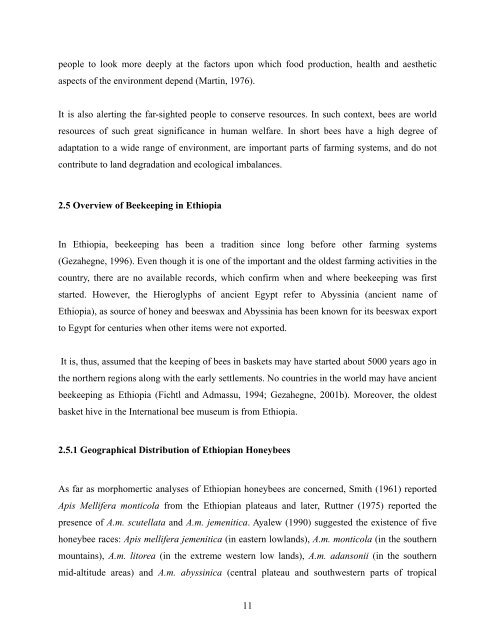Honeybee Production and Marketing Systems, Constraints - IPMS ...
Honeybee Production and Marketing Systems, Constraints - IPMS ...
Honeybee Production and Marketing Systems, Constraints - IPMS ...
- No tags were found...
You also want an ePaper? Increase the reach of your titles
YUMPU automatically turns print PDFs into web optimized ePapers that Google loves.
people to look more deeply at the factors upon which food production, health <strong>and</strong> aestheticaspects of the environment depend (Martin, 1976).It is also alerting the far-sighted people to conserve resources. In such context, bees are worldresources of such great significance in human welfare. In short bees have a high degree ofadaptation to a wide range of environment, are important parts of farming systems, <strong>and</strong> do notcontribute to l<strong>and</strong> degradation <strong>and</strong> ecological imbalances.2.5 Overview of Beekeeping in EthiopiaIn Ethiopia, beekeeping has been a tradition since long before other farming systems(Gezahegne, 1996). Even though it is one of the important <strong>and</strong> the oldest farming activities in thecountry, there are no available records, which confirm when <strong>and</strong> where beekeeping was firststarted. However, the Hieroglyphs of ancient Egypt refer to Abyssinia (ancient name ofEthiopia), as source of honey <strong>and</strong> beeswax <strong>and</strong> Abyssinia has been known for its beeswax exportto Egypt for centuries when other items were not exported.It is, thus, assumed that the keeping of bees in baskets may have started about 5000 years ago inthe northern regions along with the early settlements. No countries in the world may have ancientbeekeeping as Ethiopia (Fichtl <strong>and</strong> Admassu, 1994; Gezahegne, 2001b). Moreover, the oldestbasket hive in the International bee museum is from Ethiopia.2.5.1 Geographical Distribution of Ethiopian <strong>Honeybee</strong>sAs far as morphomertic analyses of Ethiopian honeybees are concerned, Smith (1961) reportedApis Mellifera monticola from the Ethiopian plateaus <strong>and</strong> later, Ruttner (1975) reported thepresence of A.m. scutellata <strong>and</strong> A.m. jemenitica. Ayalew (1990) suggested the existence of fivehoneybee races: Apis mellifera jemenitica (in eastern lowl<strong>and</strong>s), A.m. monticola (in the southernmountains), A.m. litorea (in the extreme western low l<strong>and</strong>s), A.m. adansonii (in the southernmid-altitude areas) <strong>and</strong> A.m. abyssinica (central plateau <strong>and</strong> southwestern parts of tropical11
















